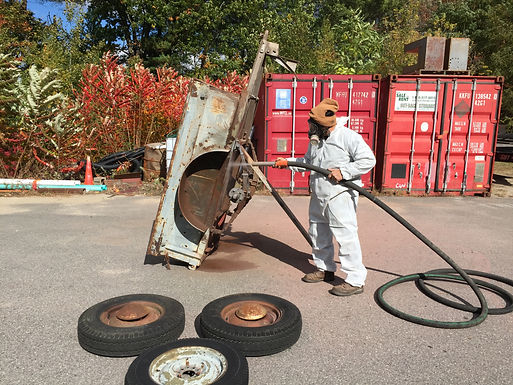
THE HAZARDS OF DUST
LEARN MORE
At Greener Blast Energy, we are committed to worker safety. When it comes to abrasive blasting, the three most significant health hazards are:
Dust
Noise
Chemicals
Of these, dust is generally considered the most serious health hazard in abrasive blasting operations.
Dust results from:
Broken-down abrasives
Pulverized surface coatings
Encrusted substances
Abraded materials from the object being blasted
The solid particles which comprise the dusts range in size from less than one micron (1/25,000 inch) to more than
1000 microns.
Under normal conditions, dust particles of 10 microns or more in diameter, settle relatively quickly. Dust particles smaller than 10 microns remain airborne longer and are easily inhaled. Smaller dust particles often settle in the lungs and sometimes small soluble particles dissolve into the blood stream.
The paramount hazard in abrasive blasting is from dust inhalation. All dusts are by no means equally toxic, nor are they equally respirable.
The dusts of major concerns are those of aerodynamic sizes (less than 5 microns) that are pulmonary fibrosis
producing (e.g., sand and granite), friable reaction producing (e.g., copper and zinc--the components of brass), or systemic poisons (e.g., lead or cadmium).
Dusts of larger size which fail to reach alveoli, nuisance dust and inert dusts, such as marble and alumina are of lesser concern.
The nature of the dust generated in any blasting process is the sum of the fragmentation of the blasting media and the material dislodged from the surface blasted. Where is friable abrasive media, such as sand, cobs, or beads is used, or where is friable
surface, such as a sand casting, a painted or scaly surface, or masonry is blasted. The dust generated is greatly
increased. Where durable media, such as steel shot, is blasted at a relatively clean surface, such as cold rolled steel,
the dust generation and resultant degree of hazard is minimized.
Unfortunately, for economic and practical operational reasons, many processes require friable abrasives to produce the desired degree of cleanliness or surface finish.
OSHA'S NEW SILICA RULE REDUCES LEGAL LIMITS
There's Just No Comparison
While each abrasive blasting offers durability, reliability, and portability, Greener Blast's wet abrasive process minimizes dust, requires minimal containment, offers the ability to move a variety of abrasives, and maximizes production. The end result? You save time and money!
